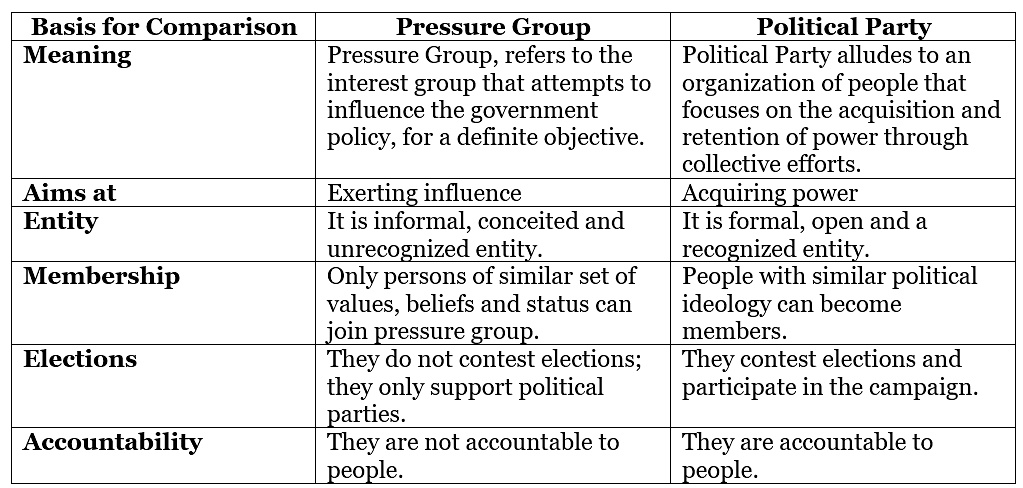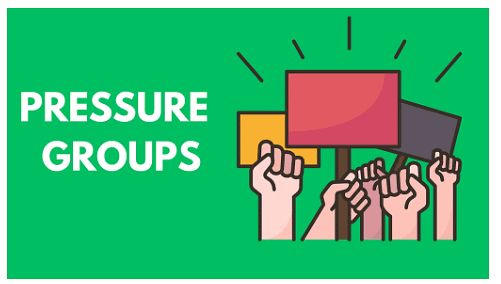Pressure Groups | Indian Polity for UPSC CSE PDF Download
Introduction
A pressure group can be described as an organised group that does not put up candidates for election, but seeks to influence government policy or legislation. They can also be described as ‘interest groups” or “vested groups“.
It includes churches and charities, businesses and trade associations, trade unions and professional associations, think tanks of various complexions etc.
Characteristics of Pressure Groups
- Pressure groups may operate at local, regional, national or even international level, depending upon the cause and notice.
- All interest groups share a desire to affect government policy to benefit themselves or their causes.
- They are usually non-profit and volunteer organization
- They seek to influence political or corporate decision makers to achieve a declared objective.
- Pressure groups are collections of individuals who hold a similar set of values and beliefs on the basis of ethnicity, religion, political philosophy, or a common goal.
- Pressure groups often represent viewpoints of people who are dissatisfied with the current conditions in society.
- These are a natural outgrowth of the communities of interest that exist in all societies.
- They never form government of contest election but influence the decision of Government or public policy. They seek to create change by being elected to public office, while pressure groups attempt to influence political parties. Pressure groups may be better able to focus on specialized issues, whereas political parties tend to address a wide range of issues.
- Pressure groups are widely recognized as an important part of the democratic process.
Types of Pressure Groups in India
A large number of pressure group exists in India but unfortunately they are not developed as compare to the Western Countries like England, France and USA. It can be classified into following categories.
Business Groups
The Business group is one of the most important, influential and organised pressure groups in India. Examples of business groups- Confederation of Indian Industry (CM), Federation of Indian Chambers of Commerce and industry (FICCI), Associated Chamber of Commerce (ASSOCHAM) – major constituents are the Bengal Chamber of Commerce Calcutta and Central commercial organisation of Delhi.
Trade Unions
Trade unions cater to the demand of workers and labours of the industries. Alternatively, they are also known as labour groups. In India, different trade unions represent different political parties. Examples- The All India Trade Union Congress (AITUC), All India Trade Union Congress (Communist Party of India).
Agrarian Groups
These groups represent the farmer community of India and works for their well-being. Example- Bhartiya Kisan Sangh, Hind Kisan Panchayat (control of socialist).
Professional Association
Such association, raise the concern of working professional in India ranging from lawyers and doctors, journalists and teachers. Examples include Association of Engineers, Bar Council of India (BCI), and Dental Council of India.
Tribal Organisation
Tribal in India are prominent in Central India and North East India, and are also active in Central Indian Tribal belt and in north east India. These organisations include National Socialist Council of Nagaland, All-India Jharkhand, and Tribal Sangh of Assam.
Linguistic Groups
There are 22 scheduled languages in India. However, there have been many groups and movements working for the welfare of languages in India. For example- Hindi Sahitya Sammelan and Tamil Sangh etc.
Ideology Based Group
Ideology based groups have been recently formed. Some examples of these groups include Environment Protection Groups like Narmada Bachao Andolan and Chipko movement, Democratic rights organisation, Gandhi Peace Foundation, Woman rights organisation, Civil liberties associations.
 |
Download the notes
Pressure Groups
|
Download as PDF |
Anomic Groups
Anomic pressure groups refer to those spontaneous groups which are formed with a collective response through riots, demonstrations , etc.
Major Pressure Groups in India
- Business Groups – FICCI, CM, ASSOCHAM, AIMO, FAIFDA etc. (institutional groups).
- Trade Unions – AITUC, INTUC, HMS, CITU, BMS etc.
- Agrarian Groups– All India Kisan Sabha, Bharatiya Kisan Union etc.
- Student’s Organisations – ABVP, AISF, NSUI etc.
- VHP, Bajrang Dal, Jamaat-e-lslami etc.
- Caste Groups – Harijan Sevak Sangh, Nadar Caste Association etc.
- Linguistic Groups – Tamil Sangh, Andhra Maha Sabha etc .
- Tribal Groups – NSCN, TNU, United Mizo federal org, Tribal League of Assam etc.
- Professional Groups – IMA, BCI, IFWJ, AIFUCT etc.
- The capacity of a pressure group is determined by:
- (a) Leadership
- (b) Organisational abilities
- (c) Mass media
- (d) Economic power base
- (e) Mobilisational techniques
Functions of Pressure groups
- Representation: Pressure groups provide a mouthpiece for groups and interests that are not adequately represented through the electoral process or by political parties.
- Political participation: Pressure groups have become an increasingly important agent of political participation. Of UK citizens, 40-50 per cent belong to at least one voluntary association. Interest groups may attempt to influence elections in order to get people who support their issues elected. Techniques include giving money to candidates, endorsing candidates, etc., are performed.
- Lobbying government: It include contacting members of parliament, ministers and bureaucrats to disseminate information about the positive or adverse effects of proposed legislation. Ex: FICCI lobby Government to bring tax reforms which suit industry.
- Educating public: Interest groups work hard to educate the public at large, government officials, their own members, and potential interest group members. They use sources like communication medium which include TV advertisements, sponsored newspaper articles, social media, etc.
- Mobilising public: The interest groups not only create public opinion but sometimes draw the general masses into agitational and protest politics. If they want to set an industry in a particular area, they create the necessary climate and make the people of the area demand for the industry.
- Policy formulation and implementation: In particular, pressure groups are a vital source of information and advice to governments. Many groups are therefore regularly consulted in the process of policy formulation, with government policy increasingly being developed through policy networks. An example of such group is Observor Research Foundation, which works on policy issues primarily related to foreign affairs.
Methods of Exerting Influence
- Lobbying with Ministers and civil servants,
- Influencing public opinion through propaganda,
- Petition to authorities
- Using judicial platforms
- Direct action i.e. protest, rallies, demonstration etc.
Limitation
- Unlike the pressure groups in the developed countries of the West, where these are invariably organised to safeguard economic, social, cultural interests, etc., in India these groups are organised around religious, regional and ethnic issues.
- Many a time factors of caste and religion eclipse the socioeconomic interests. The result is .they are reduced to work for narrow selfish interests. Moreover, many of the groups have a very short life because of the lack of resources. This explains the reason for the mushroom growth of pressure groups as well as their withering away as it becomes difficult to sustain the interest of the persons, initially attracted to form these pressure groups.
- In a country like India the tendency to politicise every issue, whether it has social, economic, cultural import, restricts the scope, working, and effectiveness of pressure groups. Instead of the pressure groups exerting influence on political process, they become tools and implements to subserve political interests. As a matter of fact, the factors which inhibit development of sound civic consciousness, also hinder emergence of healthy and functional pressure groups as a legitimate means of projecting legitimate socio-economic-ethnic and cultural interests of the citizen.
Concerns related to Pressure groups in India:
- Narrow selfish interests: Unlike the pressure groups in the developed countries of the West, where these are invariably organised to safeguard economic, social, cultural interests, etc. in India these groups are organised around religious, regional and ethnic issues.
- Misuse of power: Instead of the pressure groups exerting influence on political process, they become tools and implements to subserve political interests.
- Instability: Most pressure groups do not have autonomous existence; they are unstable and lack commitment, their loyalties shift with political situations which threatens general welfare. Ex: Naxalite movement started in 1967 in West Bengal.
- Propagating extremism: Pressure groups can allow too much influence over the government from unelected extremist minority groups, which in turn could lead to unpopular consequences.
- Political interest: Instead of the pressure groups exerting influence on political process, they become tools and implements to serve political interest.
- Lack of accountability: Regardless of which groups are most powerful, pressure group influence is exerted in a way that is not subject to scrutiny and public accountability. Pressure groups usually exert influence behind closed doors.
- The leadership of these groups tends to lack democratic organisation. Therefore, they may not actually present a true of picture of public opinion, but instead may demonstrate the desires of the leader who articulate the groups policy interests to government.
Pressure Group vs Political Party

Conclusion
In a democratic nation like India, Pressure groups provide an informal means to meet and serve needs of different classes and sections of society. However, pursuit of illogical and unnecessary demands should not override affirmative action to ensure a vibrant and inclusive polity.
|
145 videos|630 docs|203 tests
|
FAQs on Pressure Groups - Indian Polity for UPSC CSE
| 1. What are the characteristics of pressure groups? |  |
| 2. What are the types of pressure groups in India? |  |
| 3. What are some major pressure groups in India? |  |
| 4. What are some concerns related to pressure groups in India? |  |
| 5. What is the difference between a pressure group and a political party? |  |



































